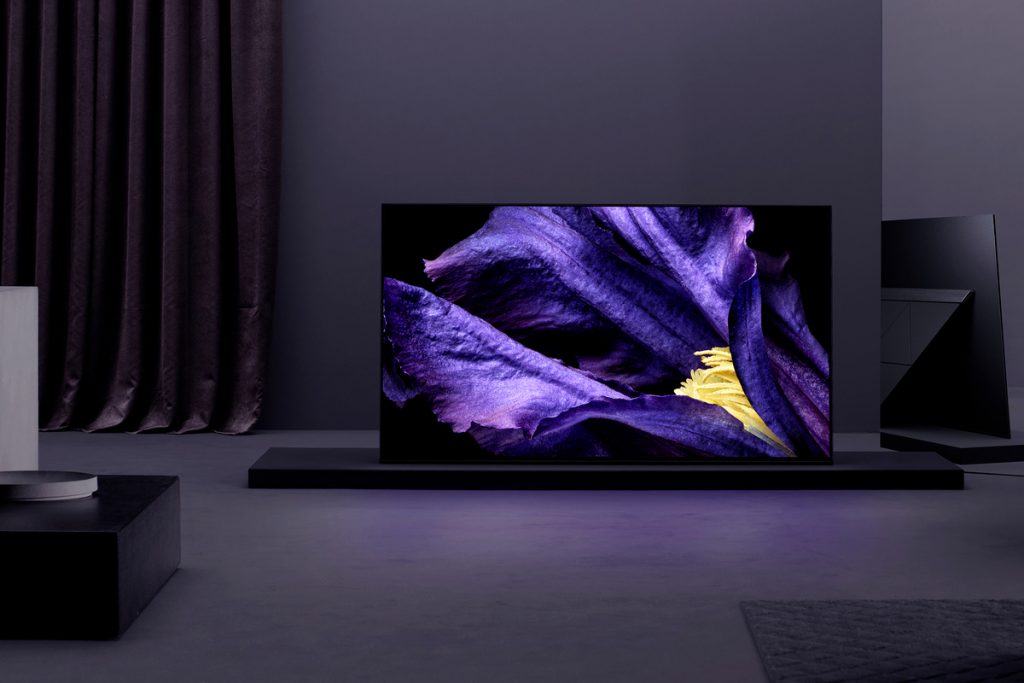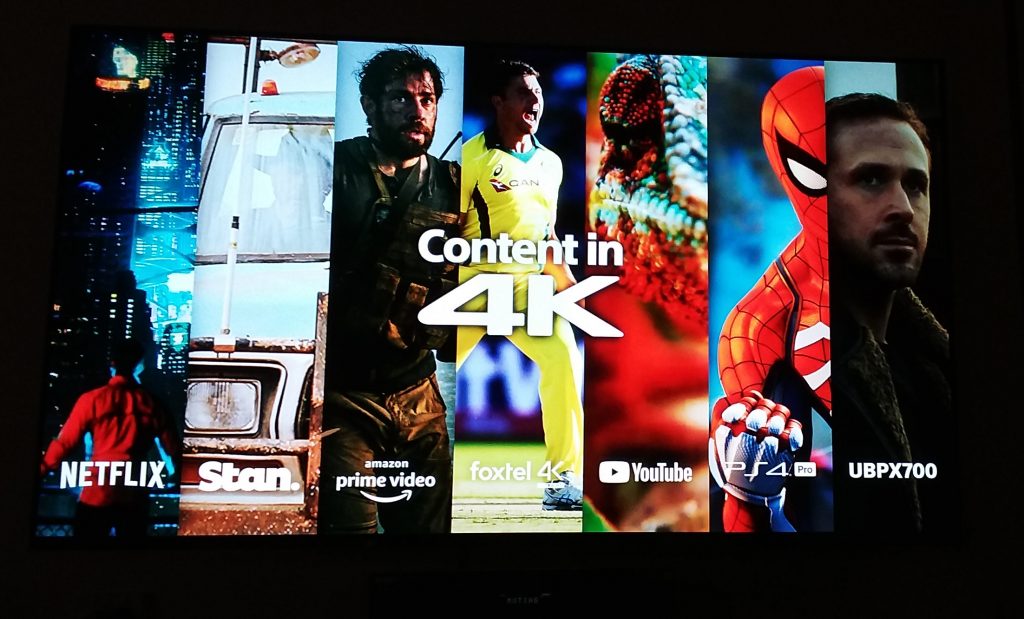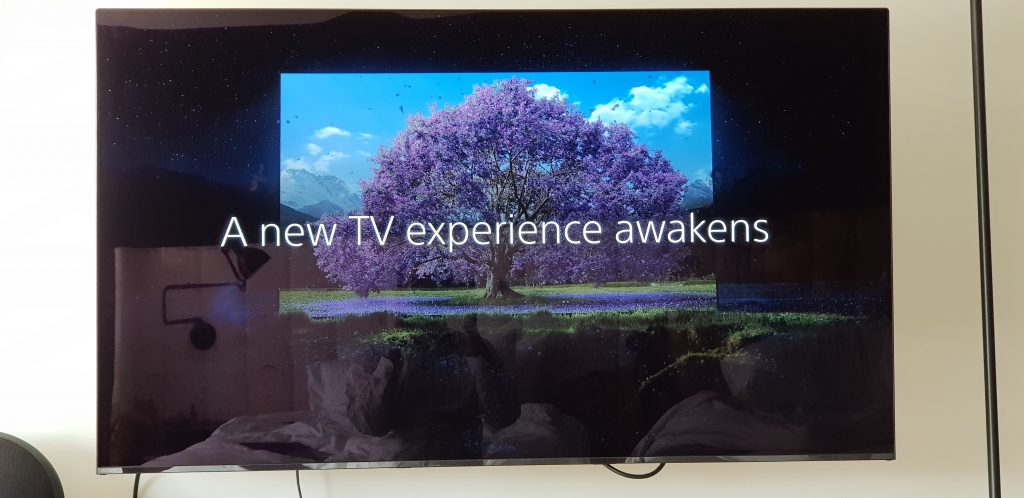Sony has let the rest of the audio visual industry know who the new OLED TV leader is by showcasing it’s new Master Series A9F OLED TV to the Australian media.
Their spokesperson told us that the aim of the Master Series of TV’s was to “design televisions that faithfully convey the creator’s intent” for home viewing. Sony’s aim is to optimise the viewing experience using technologies like their new X1 Ultimate image processor, Pixel Contrast booster, HDR (HDR10, Hybrid Log-Gamma and Dolby Vision), very wide viewing angles and ultra low input lag.

The A9F is the Bugatti Chiron of TV’s. Made for people who desire a TV in which engineering has been taken to the max, with cost being irrelevant. We came to this conclusion while watching the Sony A9F OLED display Jeremy Clarkson powering through Italy on Amazon Prime’s 4K show The Grand Tour.
What It Looks Like
The stand design is very similar to the previous A1E Sony OLED TV and the screen tilts slightly back if sitting on an entertainment unit.
You can wall mount the A9F but you cannot remove the stand because a lot of the TVs hardware is contained inside.
The Sony logo is discreetly small at the bottom left of the screen as you are viewing it. At the centre bottom there is a small activity light that can be turned off altogether.
Pros: What It’s Good At
This TV is fast, a word that we’ve not used to describe previous Sony Android TV’s. In comparison the A9F time to turn on was swift.
The general interface was also so much faster than last year’s Sony Android TV models with no lag when moving around the menus and switching between home and apps.
Hopefully older Sony Android TV’s get a similar performance improvement if they also get updated to Android 8.0.
It’s unclear whether the A9F was faster because of Android TV 8, a better processor or software optimisations.

4K Content
Obviously the A9F excels at displaying native 4K content such as Netflix, Stan, Amazon Prime Video, the new Foxtel 4K channel, YouTube, PS4 Pro and 4K Bluray content. Our test TV gave us the opportunity to test Netflix, Stan, Amazon Prime Video and YouTube Video. Unfortunately the attached Bluray player didn’t work with 4K discs and Sony didn’t have a spare player at the test venue. Suffice to say that 4K content on all these platforms displayed flawlessly and the 1080P Blu-ray movie we tested “Crouching Tiger Hidden Dragon” was upscaled to a very good standard.
Android TV built-in
Android TV functionality means you can control the A9F by voice, and use it to control other devices in your home like lights and vacuum cleaners. That same functionality is included in the new Sony Z9F 75″ 4K LED TV which features in the video below.
One of the first things we tested with the A9F was telling the TV to play Altered Carbon on Netflix and then This Week in Tech on YouTube. Both commands worked fine.
You can also change TV settings without using the remote. For example Hey Google Go Home, Hey Google go to HDMI 1. Alexa commands also work similarly if you prefer that smart speaker ecosystem.
If you’re a Netflix addict take note that Sony’s Master Series A9F OLED and Z9F LED TVs exclusively have Netflix Calibrated Mode.
This is a new feature developed by Sony picture quality and device experts in collaboration with Netflix colour scientists. By default, this setting is turned off, which is a little strange.
This feature leverages Sony’s strength in image processing to provide a display mode that configures the TV the same way creators calibrate their monitors in post production. You can use this for any type of content on Netflix. The aim is to show precise colors, accurate dynamic contrast, and true motion so there’s no “soap opera effect.”
Potential Cons: Things to Consider
The biggest potential risk with any OLED TV is burn-in if you display static content. For stations which broadcast a static station logo (e.g. ABC News 24) there is a risk of the image being burnt into the screen.
The A9F displayed the primary 1080i broadcast free to air TV channels reasonably well. It was also quite decent for 720P and 480P secondary channel content.
However there’s only so much upscaling and image processing can do for non 4K video content.
If you mostly watch broadcast TV, catchup free to air tv and Foxtel non 4K channels then spending lots of money on a high end 4K TV like the A9F is a waste of money. Get a cheaper OLED or LED TV instead.
Ideally this tv is installed in a media room where you can control the lighting. However it looks quite good with minimal reflections in a brightly lit room.
Reflections are hard to avoid, especially when you consider that TV viewing surfaces are getting bigger and bigger over time. The A9F does a pretty good job of minimising reflections, but you shouldn’t expect that you’ll avoid them completely.

The Acoustic Surface Audio + functionality where the screen acts as speakers is impressive. I’d say it is the best built-in TV audio I’ve experienced. However, someone who can afford to buy this expensive TV is likely to buy a proper Dolby Atmos sound system to use with it.
Fortunately, Sony’s A9F can pass Dolby Atmos through to your sound system using HDMI eARC. Better yet, the TV acts as a centre speaker, freeing up your choices.
Should You Buy a Sony A9F OLED 4K TV?
This TV is an engineering challenge. Sony has designed it to hit the limits of what’s currently possible with OLED TV technology. Thus, Sony have priced it accordingly.
The A9F 55″ model is available for $4998 RRP and the A9F 65″ $6499 RRP via Sony Online and major electronics retailers. If money is no object then the A9F Master Series TV’s are an easy option.
If you’re not flush with quite so much cash and keep an eye out for sales then there are many very good OLED options with street prices of around $2000-$3000.
Lastly there are many quite good TV’s available for $1000-$1500 street price thanks to intense competition in the LED 4K market.
Examples include the Hisense 55P7 whose review we will publish soon and the TCL C6 55″ that Duncan reviewed recently.
























I find the kick-stand quite objectionable – unless you wall-mount, you get your picture warped out of the box; potential for weird reflections if you have overhead lighting; and possible problems fitting onto your existing furniture. And for the sake of what exactly? Is it some sort of aesthetic objection to traditional stands? Or an attempt at vertical space-saving? Whatever it is, I am definitely non-plussed by it – it basically says that they couldn’t work out how to construct a stand that lets the screen sit flush with the table surface (clearly the primary design goal here for whatever… Read more »
I’m with you on that. Thankfully the previous A8F models don’t have that issue.
A8F isn’t a previous model. The A9F will sit above it as the higher spec variant in the Sony lineup. Note the F is in reference to the generation being 2018. The 2017 model was an E. The A8F is about a grand or so cheaper in a 65inch and readily available. With a stand that is perfectly vertical.